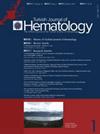Identifying Risk Factors and Improving Preventive Strategies for Febrile Neutropenia in Children with Leukemia Receiving Ciprofloxacin Prophylaxis
IF 1.5
4区 医学
Q3 HEMATOLOGY
引用次数: 0
Abstract
The purpose of this study was to identify risk factors and improve preventive strategies for febrile neutropenia (FEN) in children with leukemia who were receiving ciprofloxacin prophylaxis. The study included 100 children with leukemia [n=80 with acute lymphoblastic leukemia and n=20 with acute myeloblastic leukemia (AML)]. Patients were divided into two groups based on whether they had three or fewer FEN episodes (Group 1) or more than three FEN episodes (Group 2). Group 1 contained 63 (63%) of the 100 patients, while Group 2 contained 37 (37%). Older age (≥7 years), leukemia type, prolonged neutropenia (>10 days), and the presence of neutropenia and hypogammaglobulinemia at diagnosis were all risk factors for having more than three FEN episodes. Our findings suggest that, in addition to ciprofloxacin prophylaxis, identifying risk factors and improving preventive strategies could help reduce FEN episodes in children with leukemia.Bu çalışmanın amacı, siprofloksasin profilaksisi alan lösemili çocuklarda febril nötropeni (FEN) için risk faktörlerini belirlemek ve önleyici stratejileri geliştirmektir. Çalışmaya lösemili 100 çocuk dahil edildi (akut lenfoblastik lösemi n=80 ve akut myeloid lösemi (AML) n=20). Hastalar üç ve üçten az FEN atağı (Grup 1) veya üçten fazla FEN atağı (Grup 2) geçirmelerine göre 2 gruba ayrıldı. Yüz hastanın 63’ünü (%63) Grup 1, kalan 37’sini (%37) Grup 2 oluşturdu. İleri yaş (≥7 yaş), lösemi tipi, uzamış nötropeni (>10 gün), tanı anında nötropeni ve hipogamaglobulinemi varlığı üçten fazla FEN atağı için anlamlı risk faktörleriydi. Bulgularımız, siprofloksasin profilaksisine ek olarak, lösemili çocuklarda risk faktörlerinin belirlenmesinin ve önleyici stratejilerin geliştirilmesinin FEN atağını azaltmaya yardımcı olabileceğine işaret etmektedir.识别接受环丙沙星预防的白血病儿童发热性中性粒细胞减少的危险因素并改进预防策略
本研究的目的是确定接受环丙沙星预防的白血病儿童发热性中性粒细胞减少症(FEN)的危险因素和改进预防策略。本研究纳入100例白血病患儿[n=80急性淋巴细胞白血病和n=20急性髓母细胞白血病]。根据患者是否有三次或更少的FEN发作(第1组)或超过三次FEN发作(第2组)将患者分为两组。100例患者中,第1组有63例(63%),第2组有37例(37%)。年龄较大(≥7岁)、白血病类型、长时间中性粒细胞减少(bbb10天)、诊断时存在中性粒细胞减少和低γ -球蛋白血症都是超过3次FEN发作的危险因素。我们的研究结果表明,除了环丙沙星预防外,识别危险因素和改进预防策略可以帮助减少白血病儿童FEN的发作。但是çalışmanın amacyi, siprofloksasin profilaksisi alan lösemili ocuklarda febril nötropeni (FEN)风险faktörlerini belirlemek ve önleyici stratejileri gelitirmektir。Çalışmaya lösemili 100 ocuk dahil edildi (akut lenfoblastik lösemi n=80)和akut myeloid lösemi (AML) n=20)。Hastalar üç ve ten az FEN atağı(1组)veya ten fazla FEN atağı(2组)gemelerine göre 2 gruba ayrıldı。y z hastanın 63′ünü(%63)组1,kalan 37′sini(%37)组2 olu turdu。İleri yaku(≥7 yaku), lösemi tipi, uzamış nötropeni (bbb10 g n), tanyi anında nötropeni ve hipogamaglobulinemi varlığı ten fazla FEN atağı iin anlamlyi risk faktörleriydi。Bulgularımız, siprofloksasin profilaksisine ek olarak, lösemili ocuklarda risk faktörlerinin belirlenmesinin ve önleyici stratejilerin gelitirilmesinin FEN atağını azaltmaya yardımcı olabileceğine iaret etmektedir。
本文章由计算机程序翻译,如有差异,请以英文原文为准。
求助全文
约1分钟内获得全文
求助全文
来源期刊

Turkish Journal of Hematology
HEMATOLOGY-
CiteScore
2.90
自引率
3.80%
发文量
45
审稿时长
1 months
期刊介绍:
The Turkish Journal of Hematology is published quarterly (March, June, September, and December) by the Turkish Society of Hematology. It is an independent, non-profit peer-reviewed international English-language periodical encompassing subjects relevant to hematology.
The Editorial Board of The Turkish Journal of Hematology adheres to the principles of the World Association of Medical Editors (WAME), International Council of Medical Journal Editors (ICMJE), Committee on Publication Ethics (COPE), Consolidated Standards of Reporting Trials (CONSORT) and Strengthening the Reporting of Observational Studies in Epidemiology (STROBE).
The aim of The Turkish Journal of Hematology is to publish original hematological research of the highest scientific quality and clinical relevance. Additionally, educational material, reviews on basic developments, editorial short notes, images in hematology, and letters from hematology specialists and clinicians covering their experience and comments on hematology and related medical fields as well as social subjects are published. As of December 2015, The Turkish Journal of Hematology does not accept case reports. Important new findings or data about interesting hematological cases may be submitted as a brief report.
 求助内容:
求助内容: 应助结果提醒方式:
应助结果提醒方式:


